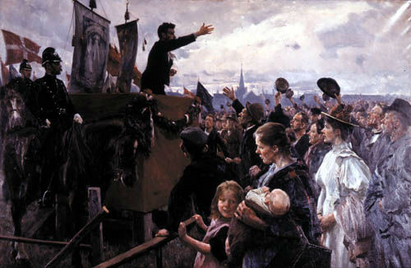
Welfare state (1915-2000)
Expectations were high in the 20th century. New thoughts and ideas came to change the view of human existence. Great hopes were harboured for the technological developments, which presented new and splendid possibilities. Electricity was the form of energy that revolutionized both the workplace and everyday life. At the beginning of the 20th century the first feature films heralded the era of the entertainment industry and mass media. Workers were gradually given more leisure time and holidays. After World War Two increasing numbers of women went out to work. The extra family incomes could be used on the new consumer durables that became available, such as televisions.
In 1901 a change of political system was introduced in the form of parliamentarianism. This meant that the government represented the majority in the Danish Parliament (Folketinget). The number of political parties increased, and the state built up a social system that looked after the weaker groups in society. With the emergence of a large new working class, Denmark became a class society, with the political parties functioning as mouthpieces for the various classes.
The Social Democrats came to power for the first time in 1924. In this government was the education minister Nina Bang – the world’s first female minister. Together with the Radical Liberals, the Social Democrats introduced a large number of welfare reforms in the 1930s. For long periods in the 1950s and 1960s the Social Democrats, as the party of government, also spearheaded a number of reforms, which provided welfare provision for the whole population. For example, in 1956 old age pension was introduced for all.
In 2000 both men and women were expected to be active members of the workforce, with the collective working hours of couples with children having risen in the 1990s. By 2000 women had to a large extent been relieved of looking after children, the sick and elderly – this had instead become society’s responsibility. By now the largest employment sector of the Danish economy was services.
More welfare state?
Visit the exhibition Stories of Denmark at the National Museum in Copenhagen.
